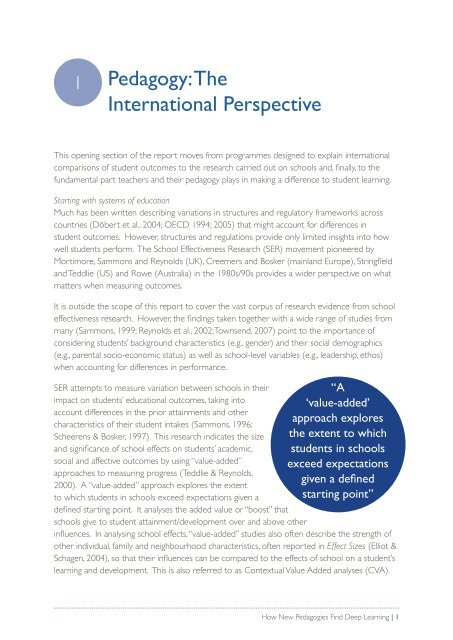Pearson-Exploring-Effective-Pedagogy-in-Primary-Schools
Pearson-Exploring-Effective-Pedagogy-in-Primary-Schools
Pearson-Exploring-Effective-Pedagogy-in-Primary-Schools
Create successful ePaper yourself
Turn your PDF publications into a flip-book with our unique Google optimized e-Paper software.
1<strong>Pedagogy</strong>: TheInternational PerspectiveThis open<strong>in</strong>g section of the report moves from programmes designed to expla<strong>in</strong> <strong>in</strong>ternationalcomparisons of student outcomes to the research carried out on schools and, f<strong>in</strong>ally, to thefundamental part teachers and their pedagogy plays <strong>in</strong> mak<strong>in</strong>g a difference to student learn<strong>in</strong>g.Start<strong>in</strong>g with systems of educationMuch has been written describ<strong>in</strong>g variations <strong>in</strong> structures and regulatory frameworks acrosscountries (Döbert et al., 2004; OECD 1994; 2005) that might account for differences <strong>in</strong>student outcomes. However, structures and regulations provide only limited <strong>in</strong>sights <strong>in</strong>to howwell students perform. The School <strong>Effective</strong>ness Research (SER) movement pioneered byMortimore, Sammons and Reynolds (UK), Creemers and Bosker (ma<strong>in</strong>land Europe), Str<strong>in</strong>gfieldand Teddlie (US) and Rowe (Australia) <strong>in</strong> the 1980s/90s provides a wider perspective on whatmatters when measur<strong>in</strong>g outcomes.It is outside the scope of this report to cover the vast corpus of research evidence from schooleffectiveness research. However, the f<strong>in</strong>d<strong>in</strong>gs taken together with a wide range of studies frommany (Sammons, 1999; Reynolds et al., 2002; Townsend, 2007) po<strong>in</strong>t to the importance ofconsider<strong>in</strong>g students’ background characteristics (e.g., gender) and their social demographics(e.g., parental socio-economic status) as well as school-level variables (e.g., leadership, ethos)when account<strong>in</strong>g for differences <strong>in</strong> performance.SER attempts to measure variation between schools <strong>in</strong> theirimpact on students’ educational outcomes, tak<strong>in</strong>g <strong>in</strong>toaccount differences <strong>in</strong> the prior atta<strong>in</strong>ments and othercharacteristics of their student <strong>in</strong>takes (Sammons, 1996;Scheerens & Bosker, 1997). This research <strong>in</strong>dicates the sizeand significance of school effects on students’ academic,social and affective outcomes by us<strong>in</strong>g “value-added”approaches to measur<strong>in</strong>g progress (Teddlie & Reynolds,2000). A “value-added” approach explores the extentto which students <strong>in</strong> schools exceed expectations given adef<strong>in</strong>ed start<strong>in</strong>g po<strong>in</strong>t. It analyses the added value or “boost” thatschools give to student atta<strong>in</strong>ment/development over and above other“A‘value-added’approach exploresthe extent to whichstudents <strong>in</strong> schoolsexceed expectationsgiven a def<strong>in</strong>edstart<strong>in</strong>g po<strong>in</strong>t”<strong>in</strong>fluences. In analys<strong>in</strong>g school effects, “value-added” studies also often describe the strength ofother <strong>in</strong>dividual, family and neighbourhood characteristics, often reported <strong>in</strong> Effect Sizes (Elliot &Schagen, 2004), so that their <strong>in</strong>fluences can be compared to the effects of school on a student’slearn<strong>in</strong>g and development. This is also referred to as Contextual Value Added analyses (CVA).How New Pedagogies F<strong>in</strong>d Deep Learn<strong>in</strong>g | 1


